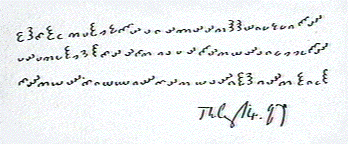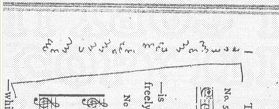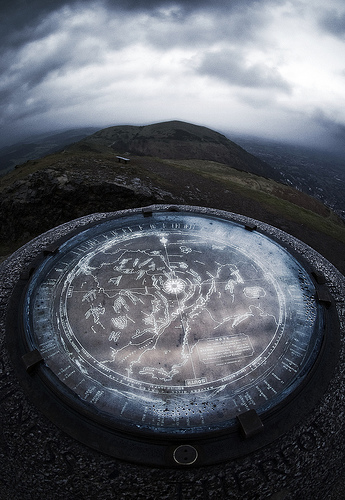![[benzedrine.ch logo]](/logo.jpg) |
|
|
|
Clues (or red herrings) to the Dorabella Cipher BackgroundIn 1897, the English composer Edward Elgar sent a letter containing an encrypted message (seen above) to his aquaintance, Miss Dora Penny (nicknamed Dorabella). To this day, the meaning remains unknown.
AnalysisThe New Scientist article suggests that the 26 letters of the roman alphabet are probably mapped to the 24 symbols by using the same symbol for I=J and U=V. Assuming the (arbitrary) key
S W Z
R U Y
Q T X
P O N A B C
K G D
L H E
M I F
the ciphertext can be read as
BPECAHTCKYFRQDRIRRHPPRDXYXGFS TRTHTCKLCERREHGQTRFRHUSQDXKKXFS ESHUSEDUWGSERHUQSDCPGSHCDXC i.e. the first symbol is two semi-circles with their open sides facing east, we pick the second eastern letter, B, etc.
 Image made by Robert S.
 1920 exercise book, birthplace museum Elgar did indeed use this cipher elsewhere. As well as the examples in the 1920's exercise book, Elgar scribbled an 18 character code using the same cipher symbols in the column of printed programme notes for a concert he attended at Crystal Palace in April 1886 - opposite a musical example from Liszt's "Les Preludes".
 1886 Liszt fragment, birthplace museum (click on image for full page) On 10 April 1886 he went to the Crystal Palace to attend a performance in honour of the seventy-five-year-old Franz Liszt. Liszt was visiting England for the first time in many years, and Manns's orchestra surpassed itself. The old Abbe shook hands with Manns and bowed many times to a cheering audience. Edward recorded his own Judgement on this music with a cipher pencilled into his programme. It was an early instance of his interest in this arcane art, more secret than a pun yet with its own show of cleverness. Many years later the cipher on Liszt's music was decoded to read: 'GETS YOU TO JOY, AND HYSTERIOUS.' (footnote: communicated by Anthony Thorley, 1977) 'Hysterious' was a portmanteau invention: it married 'hysteria' with 'mysterious' throu a 'tear'.
SpeculationThere are 24! (or 620,448,401,733,239,439,360,000, about 6.2*10^23) possible keys. It appears unlikely that Elgar expected Dora to deduce the key mathematically. I suspect the key was known to Dora, but she didn't recognize it as such.Could the eight directions of the cipher symbols correspond to the eight directions on a compass rose? Elgar and Dora shared a love for the Malvern Hills. According to Dora's memoirs, she received the letter on July 14th 1897, after a visit by Elgar and Alice earlier that month. She remembered one of the topics of conversation was map reading. Could there be one specific map Elgar assumed Dora would think of? There is a unique map on top of Malvern Hills, in form of a toposcope at the peak of Worcestershire Beacon. More intriguingly, the toposcope was installed in the year 1897, in celebration of Queen Victoria's diamond jubilee. And it features drawings made by Troyte Griffith, a friend of Elgar's.
 Worcestershire Beacon, Malvern Hills, by Primed Minister Maybe the engravings are placed in a way that allows to unambiguously associate three letters with each of the eight directions, so the monument is the translation key. The frequency distribution in the ciphertext matches that of the English language, but if Elgar used creative spelling and word choices (as he was known to do, in other letters) to defeat simple analysis, maybe the alogrithm IS just a simple substitution cipher, which hasn't been cracked yet due to the untypical properties of the enciphered text? However, would Elgar have thought that the letter would ever be analyzed by people with cryptographic skills? Another explanation would be that while the substitution is monoalphabetic, there is some form of transposition. Something that Dora would have noticed visually, had she reversed the substitution, like writing lines from right to left, or rows (top to bottom, or reverse) instead of lines, or even diagonally. The ciphertext contains three lines, with 29, 31, and 27 symbols respectively. Should we assume the order is neccessarily line by line, from left to right? If so, why aren't there three lines of 29 symbols each? The spacing between the symbols does not appear to be precise. One possibly interesting property of the symbol set is that every symbol can be rotated and mirrored, always producing another valid symbol. If you have any feedback, especially any detailed pictures of the toposcope, I'd love to hear from you. Please send (plain text, non-HTML) email to daniel@benzedrine.ch. -- Daniel Hartmeier, April 27th 2006
Update: more images of the toposcope were found: topodisk.gif, toposcopering.jpg, toposcope.jpg, toposcope2.jpg.
Quotes from Dora's bookEdward Elgar - Memories of a VariationMrs. Richard Powell Third edition by Methuen & Co. Ltd. in 1949
Pages 6 and 7: After luncheon he suggested a walk and we spent the afternoon
Page 10: I saw, for the first time, the poker-work design over the
Troyte Griffith: A Malvern Enigma in Malvern TheatresFound through google (in April 2006), the original URL produces a HTTP 403 (Forbidden) error, but the following was readable through google's cache:
First published on Friday 17 October 2003:
|